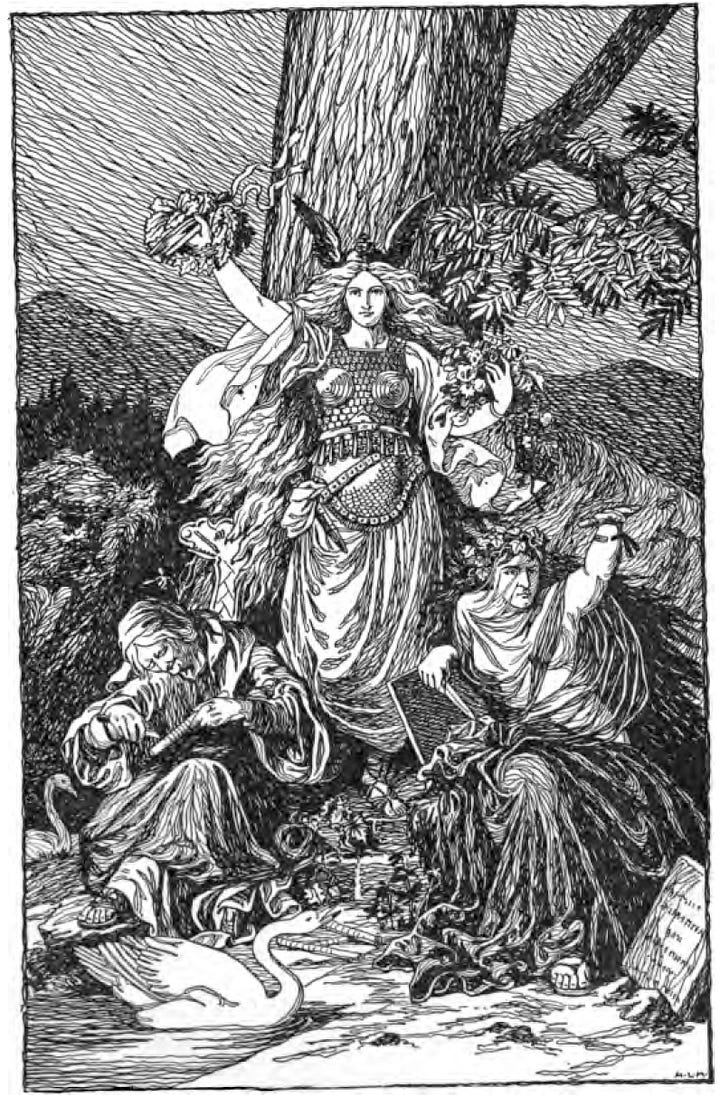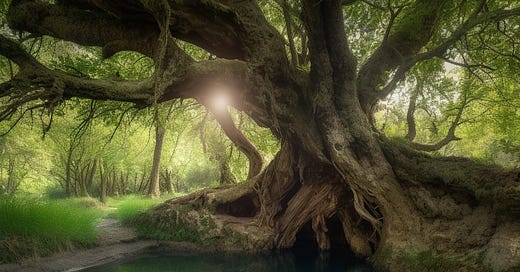Spring is humming all around the countryside and my home is filled with beautiful flower bouquets and posies. Being so surrounded and immersed in the verdant hum of spring, I frequently feel quite dissociated as Halloween decorations appear in more and more houses, gardens, and shops. Images of pumpkins, black cats, spiders, monsters, skeletons, ghosts and other ghoulish decorations are the hallmark of Samhain, an ancient celebration that marks the end of Autumn and the start of Winter, which has become our modern Halloween. It feels so strange to me that we’ve adopted this distinctly autumnal celebration from the northern hemisphere during the middle of our spring in the southern hemisphere.
I do, however, adore the excitement and anticipation of Halloween and its mainstay of trick-or-treating. This secular tradition sparks the imagination and sense of fun for children and adults alike. I just wish we could ground our celebrations in the joys of this beautiful spring season, instead of importing autumn decorations wholesale from the northern hemisphere. I would love to see more witches be-decked in flowers, colourful ribbons streaming from broomsticks, skulls decorated with bright colours and blossoms, and even icons of the Latin American celebration of Dia de Muertos (Day of the Dead), with its own festively floral themes, which we will explore in the last week of October.
I can’t begrudge the fun though, so my house will be decorated and I will enjoy trick-or-treating with my children, with a twist, a nod to the season and the traditions of Beltane: my own flowery witch costume, ribbons and flowers in my broomstick, a stag skull stuck on a spike in the front garden decked in ribbons and bells and a blossom-filled hawthorn branch. I also celebrate Beltane in a more private and personal way, tying clooties in a nearby hawthorn tree and washing my face and hands in the early morning dew on Beltane morning. We will be exploring these traditions involving water, morning dew, springs and wells in today’s episode. Let’s dive in!









The Ancient Waters of Beltane
As we have heard in the previous episodes about Beltane (Air and Fire), Beltane is an ancient tradition celebrated throughout Europe, though differently named according to each specific culture, most often referred to as May Day. In many of these places, including the Celtic lands, revering water in some way was an important folk custom, whether that meant visiting wells and springs, or bathing in early morning dew.
Springs and Wells
In a previous episode about Imbolc and Brigid’s Day, we explored the custom of visiting sacred wells and springs connected to the goddess and/or Saint Brigid.

These sacred wells were believed to have healing properties and people often made pilgrimages to them to wash their wounds or cleanse their bodies with the healing waters. These pilgrims often dipped a piece of rag, called a clootie, into the water and tied it to a nearby tree, usually a Whitethorn or Ash tree. It was believed that as these clooties rotted away, so would a person’s illness or troubles.
The belief that sacred springs or wells could cleanse the visitor of illness or ill fortune was and still is widespread across Europe, as is the custom of visiting these wells or springs at Beltane (May Day).
The video (2:35 mins) below depicts a pilgrimage of students from Notre Dame University to a sacred well in Ireland, Mám Éan, located in the Maumturk Mountains of Connemara. Although it is an important site for Irish Catholics, it has ancient pagan roots and the veneration of wells and springs has survived for thousands of years.
Another ancient spring, Cathair Crobh Dearg, in Shrone, County Kerry, is said to be one of the oldest Christian pilgrimage sites in Ireland and an important pagan fertility site long before Ireland was Christianised. The spring sits just outside a stone ráth, an ancient ring fort that legends say was the first place the Tuatha Dé Danann (a mythological and supernatural race) settled when they came to Ireland.
The site sits in the shadow of Dá Chích Anann (the Paps of Anu), a double-peaked mountain said to be the breasts of Anu, the mother goddess of the Tuatha Dé Danann. Until the early 20th century, large celebrations were held at the spring on Beltane (May Day). Cattle from the surrounding region were driven in a circle around the well and given water from the spring, which blessed them with good health and protected them from evil.



People still venerate the spring and take the waters for healing though its powers are now attributed to one of three Christian sister saints, Crobh Dearg (Red Claw). Interestingly, in ancient Celtic mythology, Crobh Dearg was one of the names of the war goddess Mórrígan. May Day celebrations are still held at the spring, though they are now small ecclesiastical affairs.
“When you stand in the middle of the Cathair you get a great feeling of satisfaction that you’re standing here on one of the most ancient places on earth where religious ceremonies of one kind or another have been enacted for the past six or seven thousand years, without a break…Tell me another place you’ll find that. You’ll find them, all right…but they’re long since broken, the sequence is broken. But not at Cromlech Cathair Crobh Dearg…There is no place in Western Europe more ancient, functioning the same length of time, as Cromlech Cathair Crobh Dearg.”
Irish Folklorist, Dan Cronin, 1999
Morning dew
… When the summer is coming
When summer is near
When the trees oh so green
And the sky bright and clear
And the wee birds all singing
Their loved ones to woo
And young flowers all springing
In the May morning dew…
Lyrics for The May Morning Dew (traditional Irish song)
According to folklore across Europe, May Day dew has magical properties and is considered particularly sacred. The most common belief is that anyone who washes their face in dew on the first of May, at dawn before it is touched by the sun, will have a flawless complexion for an entire year. It was also said to remove spots, freckles, and pimples, prevent headaches and ease soreness, as well as grant the practitioner the ability to untangle knots in nets, ropes, and threads.
Some folk traditions believe dew should be collected from ivy leaves, from a flowering hawthorn tree, or from grass under oak trees and some believe that dew collected from green heads of wheat is the most powerful. All traditions agree that the dew is only effective at or just before sunrise.


The dew could also be collected and stored in a glass bottle to be used at other times of the year for healing and good luck. Dr Gerard Boate wrote about this custom in 1652 (remembering that Celtic peoples split the year into two seasons, summer and winter with winter beginning at Samhain and summer at Beltane):
From Dr. Boates’ ‘The Natural History of Ireland’
The English women and gentlewomen in Ireland, as in England, did use in the beginning of the summer to gather good store of dew, to keep it by them all the year after for several good uses both of physick and otherwise. Their manner of collecting and keeping it was this. In the month of May especially, and also in part of the month of June, they would go forth betimes in the morning, and before sun-rising, into a green field, and there either with their hands strike off the dew from the tops of the herbs into a dish, or else throwing clean linen cloaths (sic) upon the ground, take off the dew from the herbs into them, and afterwards wring it out into dishes: and thus they continue their work until they have got a sufficient quantity of dew according to their intentions.
That which is gotten from the grass will serve, but they chuse (sic) rather to have it from the green corn, especially wheat, if they can have the convenience to do so, as being persuaded that this dew hath more vertues (sic) and is better for all purposes than that which hath been collected from the grass or other herbs. The dew thus gathered they put in a glass bottle and so set it in a place where it may have the warm sunshine all day long, keeping it there all the summer; after some days rest some dregs and dirt will settle to the bottom; the which when they perceive, they pour off all the clear dew into another vessel, and fling away those settings. This they do often as those good women see any notable quantity; they still pour off the clear dew from them: doing thus all summer long, until it be clear to the bottom. The dew thus thoroughly purified looketh whitish, and keepeth good for a year or two after.

The tradition of washing the face in the morning dew on the first of May was popular in Edinburgh, Scotland as recently as the 1980s. Acclaimed Edinburgh poet Robert Fergusson wrote about the tradition in 1773:
On May-day in a fairy ring
We’ve seen them round St Anton’s spring
Frae grass the caller dew-drops wring
To weet their een
And water clear as crystal spring
To synd them clean.

There are a number of folk songs and sayings related to washing in dew on May Day.
The maid who rises in the early morn of May, and washes in dew from the hawthorn tree, will ever after handsome be.
Another version:
The fair maid who, on the first of May, goes to the fields at the break of day, and washes in the dew of the hawthorn tree, will ever after handsome be.
And another version:
If you wash yourself in the May dew, your cheeks will be rosy all year through.
There is even a traditional riddle related to this custom:
I washed my face in water that had neither rained nor run, and dried it on a towel that was never woven or spun.
Answer - dew left on the face to dry
In other regions of Europe such as Serbia, Ukraine, and Bulgaria it was traditional for women and girls to go out of the village and into wild, uncultivated meadows and fields, singing songs. They went to wash themselves in the dew to bring beauty, and health and to ensure that women of child-bearing age conceive without difficulty and have safe, uncomplicated births. Morning dew was also used throughout the year, across Slavic nations in folk magic and medicine.


In the Nordic sagas, Urd is one of the three Norns who determine the fate of humans and humankind. She is also the Norse Goddess of life and death. Every night, while people are dreaming, their memories coalesce into dew. Every morning Urd wakes before dawn to gather the morning dew, which is people’s collective memories, and pours it into Urðarbrunnr, the Well of Memories at the base of Yggdrasil, the Tree of Life, which keeps it alive. The Well of Life must be replenished with dew every day for if people forget, if their memories are not collected, the Well of Memories dries up and the Tree of Life will die. According to ancient Nordic belief, life is maintained through our memories in the morning dew.


I hope you enjoyed this week’s episode. Next week, we’ll explore the Earth-based Beltane traditions of ‘A-Maying,’ the May Bush, May Poles and flower wreaths. In the meantime, I’ll leave you with this Beltane blessing from a Scottish Gaelic song collected by 19th-century folklorist Alexander Carmichael, heard from a crofter in South Uist, Scotland:
Bless, O threefold true and bountiful,
Myself, my spouse and my children,
My tender children and their beloved mother at their head,
On the fragrant plain and the gay mountain sheiling,
On the fragrant plain and the gay mountain sheiling.
Everything within my dwelling or possession,
All kine and crops, all flocks and corn,
From Hallow Eve to Beltane Eve,
With goodly progress and gentle blessing,
From sea to sea, and every river mouth,
From wave to wave, and base of waterfall.
















Share this post